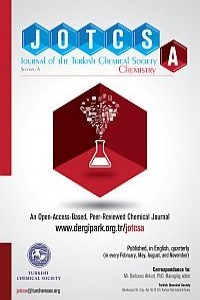Güneş Pillerinde Kullanılabilecek Ditiyenotiyofen – Benzotiyadiazol İçeren Donör – Akseptör Kopolimerlerin Sentezi ve Karakterizasyonu
İletken polimerlerin keşfinden bu yana araştırmalar yeni iletken malzemelerin geliştirilmesi için yeni tür polimerlerin dizayn edilmesi ve sentezlenmesi üzerinde yoğunlaşmaktadır. Wynberg ve çalışma arkadaşları donör – akseptör kopolimerleri keşfetmiş ve bu keşif büyük ilgi görmüştür.Bu kopolimerlerin en önemli özelliği π elektronlarının elektron fazlalığı ve azlığı içeren gruplar üzerinde delokalize olması nedeniyle bant aralıklarının kısalmasıdır. Bu amaçla çeşitli donör ve akseptör gruplar bulunmuştur ve ışık yayan diyodlar (LED) ve güneş pilleri (Solar Cell) uygulamaları için uygun oldukları gözlemlenmiştir Birbirine bağlı üç adet tiyofen halkası içeren Ditiyenotiyofenler elektronca zengin bir yapıya sahiptir bu nedenle donör özellik göstermeleri beklenmektedir Son zamanlarda yapılan çalışmalarda eskiye oranla daha iyi donör özellik gösteren yapılar keşfedilmiş ve güneş pili uygulamaları için özellikleri incelenmiştir. Bu çalışmada ise, DTT-Btz grupları içeren donör akseptör kopolimerlerinin sentezi ve karakterizasyon işlemleri yapılmıştır.
Anahtar Kelimeler:
-
Synthesis and Characterization of Donor-Acceptor Copolymers Having Dithienophene – Benzothiadiazol Moieties Suitable for Use in Solar Cells
Since the discovery of conducting polymers, researches have been focused on the design and synthesis of new type polymers for development of novel conductive materials. Wynberg et al. have discovered donor-acceptor copolymers and this event has received a great deal of interest. The most important feature of these copolymers is that the band gaps are lowered because of the delocalization of π electrons over electron-donating and electron-accepting groups. For this purpose, several donor and acceptor groups were introduced and they have been concluded to be suitable for light emitting diodes (LEDs) and solar cells. Dithienothiophenes, comprising three fused thiophene rings, have a quite rich electronic structure and therefore, they are expected to show a donor-type behavior. Recently, better donor-type groups were discovered when compared to the ones in the past and their properties were investigated in terms of usability in solar cell applications. In this study, we have synthesized and characterized DTT-Btz-containing donor-acceptor copolymers.
Keywords:
-,
___
- ] (a) Havinga, E.; ten Hoeve, W.; Wynberg, H. Polym. Bull. 1992, 29,119−126; (b) Havinga, E.; ten Hoeve, W.; Wynberg, H. Synth. Met. 1993, 55,299−306.
- ] (a) Öktem, G.; Balan, A.; Baran, D.; Toppare, L. Chem. Commun. 2011, 47, 3933; (b) Shen, C.; Rubin, Y.; Wudl, F. Angew. Chem. 2004, 116, 1524−1528; (c) Hains, A. W.; Liang, Z.; Woodhouse, M. A.; Gregg, B. A. Chem. Rev. 2010, 110, 6689−6735; (d) Beaujuge, P. M.; Subbiah, J.; Choudhury, K. R.; Ellinger, S.; McCarley, T. D.; So, F.; Reynolds, J. R. Chem. Mater. 2010, 22, 2093−2106.
- ] Ozturk, T.; Ertas, E.; Mert, O. Tetrahedron, 2005, 61, 11055-11077.
- ] Jorgensen, M. ;Norrman, K.; Gevorgyan, S. A.; Tromholt, T.; Andreasen, B.; Krebs, F. C. Adv. Mater. 2012, 24, 580-612.
- Başlangıç: 2014
- Yayıncı: Türkiye Kimya Derneği
Sayıdaki Diğer Makaleler
Pirol Birimleri İçeren Yeni Bir Schiff Bazı Ligandı ve Zirkonyum Kompleksleri
Salih TUNALIBERBERLER, Ozan ŞENTÜRK
Mertcan ÖZEL, İpek ÖSKEN, Turan ÖZTÜRK
α,β-Doymamış Karbonil Bileşiklerinden BODIPY Moleküllerinin Sentezi
Fuller Toprağı ile Aerojel Üretimi
Semanur YAVUZ, Esra TANRISEVEN
Polisülfonun Klorometillenmesi
β - Sübstitüe Kaliks[4]Piroller ve Tuzlarının Sentezi
Polimer Karışımlarının Hazırlanması ve Özelliklerinin İncelenmesi
Atomik Absorpsiyon Spektrofotometresi ile Deodorant ve Rimel Örneklerinde Eser Element Tayini
